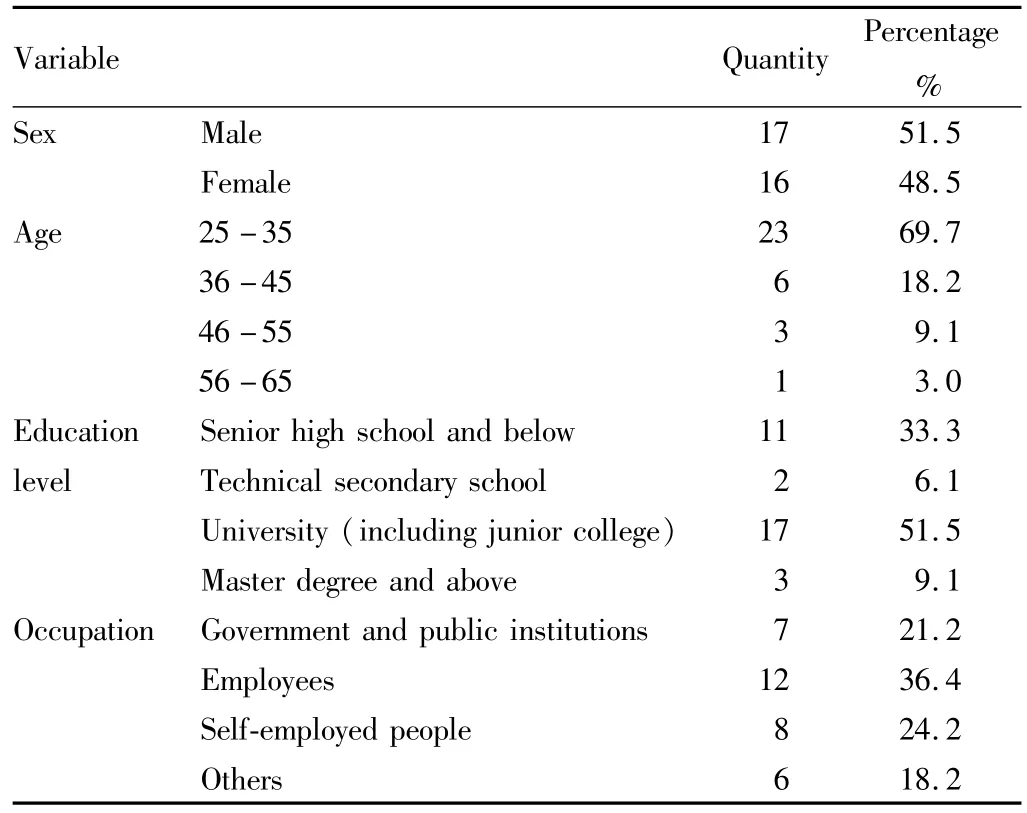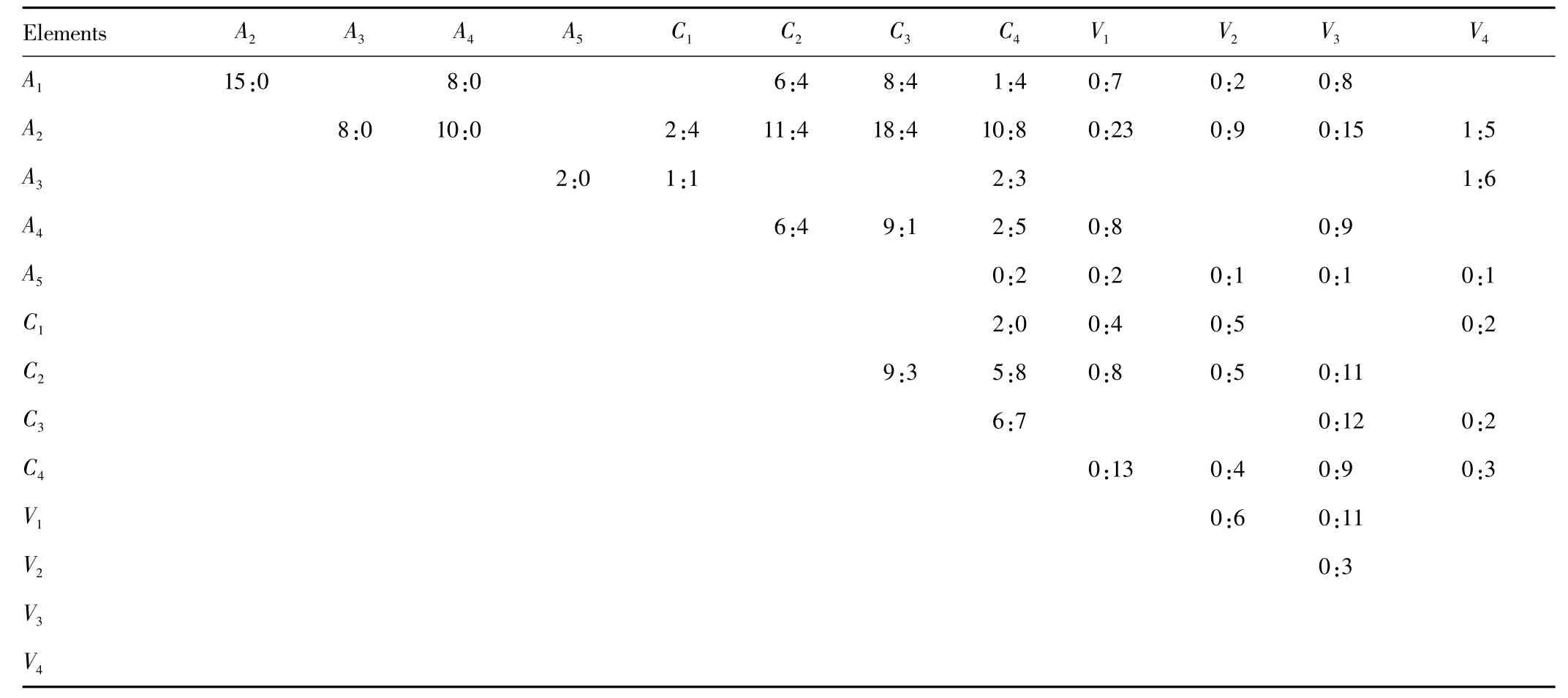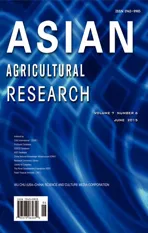A Study of Regional Brand Positioning Strategy for Linhai Orange Based on Soft Laddering
2015-02-06YingTAOYueliZHANG
Ying TAO,Yueli ZHANG
College of Economics and Management,Zhejiang A&F University,Lin'an 311300,China
1 Introduction
From the theoretical or practical point of view,brand positioning plays a crucial role in the process of brand building.At present,there have beenmany problems in quite a number of Chinese enterprises when brand is developed to a certain stage due to fuzzy brand positioning,eventually leading to failure.Zhejiang Province is a major orange producer in China,and many important orange producing areas have expanded sales by building the regional brand to improve the competitiveness of orange.In justa decade,Zhejiang's Linhai Orange has become a well-known regional brand,and won the honors of Famous Brand in Zhejiang Province and Ten GIRegional Brands in Zhejiang Province.It becomes a promising new brand of orange in the province.However,there are still many problems restricting the development of Linhai Orange brand such as unobvious shelter effect of regional brand and chaotic individual brand. Therefore,with Linhai Orange in Taizhou City as sample,we use"Means-End Chain Theory"based on soft laddering to conduct in-depth interviews with 33 LinhaiOrange consumers.Through the survey of Linhai Orange consumers' personal value demand,we establish the"Attributes-Consequences-Value"matrix and hierarchical value map according to the survey results,to finally get the real needs of consumers for LinhaiOrange,in order to explore the regional brand positioning strategy of Linhai Orange,promote the building and extension of Linhai Orange brand,and enhance sustained development of Linhai Orange brand.
2 Soft laddering
Currently,the mainstream analysis method of Means-End Chain Theory(MEC)is a qualitative research method-laddering method,which uses induced way to find the relationship between consumers and ACV(Attributes,Consequences and Value)of products,and build the ACV structure.Soft laddering developed by Gutman is one of the laddering methods.Soft laddering operates in the form of"… in-depth interviews with respondents following as far as possible their natural flow of speech…".In soft laddering,researchers aim to learn the meaning of the given answers and to link them to the means-end chain model.Soft laddering is a process of reminiscence,which can reveal more details on the product perception,so it is suitable for small-size sample survey.
3 Research methods
In this study,we use the Means-End Chain Theory for the study on positioning strategy of LinhaiOrange brand.Means-End Chain Theory(MEC)is described by Grunert and Valli(2001)as the most promising theoretical progress in the consumer research since the 1980s,and developed by Gutman(1982)on the basis of Means-End Theory proposed by psychologist Tolman(1932)and economist Abbott(1995).Means-end chains are a set of measures for the purpose of questioning interview participants regarding the reasons for their decision choice and capturing the responses in terms of linkages between different outcomes.Means-End Chain Theory is a simple structure linking attributes,consequences and values,and through the A-C-V(Attributes-Consequences-Values)connection,we can explore the consumers' value target and describe the meaning of goods or services to consumers.This study is the interview survey based on soft laddering,and according to scholars' use of this method in the study,we can get plenty of interview information by interviewing 30-50 people,so we interview a total of 33 respondents.From specific product attributes to consumption consequences and personal values,we ask the respondents questions in one-to-one way until the respondents can not give the answer.At this point,the interview is over.Then using content analysis,we encode the relevant information about attributes,values and consequences,build the meaning matrix and make the hierarchical value map which reveals the dominant orientation of value chain,and reflects the A-C-V connection for Linhai Orange consumers.
3.1 Data collectionIn this paper,we use soft laddering for data collection and analysis,and links the product attributes with personal values.The interview steps based on soft laddering start from asking some questions such as"Why is it important to you?",to the progressive questions on specific product attributes,consumption consequences and personal values,to get the consumers real demand for LinhaiOrange.Interview forms are as follows:
The questions are continued until consumers can not give an answer.Using one-to-one way,the interviews spanned from November 2014 to December 2014,lasting two months,and the interview with each respondent took about 30 minutes or so.Interview principle is to allow respondents to talk in a relaxed and comfortable atmosphere,and timely adjust questions for different persons,to get information as much as possible.

Table 1 Demographic characteristics of respondents
3.2 RespondentsThe interview used by soft laddering is indepth interview,which is relatively time-consuming in the survey,so we use the convenience sampling way in the research.The interview object is the person having ever actually consumed Linhai Orange.Based on previous scholars' research results,we successfully interviewed 33 Linhai Orange consumers.Respondents include 17males and 16 females;there are 23 respondents aged 25-35,accounting for 69.7%;there are 6 respondents aged 36-45,accounting for 18.2%;there are 3 respondents aged 46-55,accounting for 9.1%;there is only one respondent aged 56-65,accounting for3%;the respondents with education level of university(including junior college)account for 51.5%,while the respondents with education level of senior high school and below account for 33.3%;21.2%of respondents working in government and institutions,24.2%of respondents are self-employed people,and the remaining respondents account for 18.2%.
3.3 Data analysisAfter obtaining the interview data based on soft laddering,the next step is to organize and process these data.The entire soft laddering process is shown in Fig.1.And the data analysis methods and processes are shown in Stage Iof Fig.1.
4 Research results
4.1 Consumption attributes,consequences and values of Linhai OrangeThrough the content analysis of soft laddering,we finally extract five Attributes(A),four Consequences(C),and four Values(V)(Table 2).In the five Attributes(A),"perceptual feature"is most frequently mentioned,followed by"regional characteristics"and so on;in the four Consequences(C),"good taste"appears most frequently,followed by"contributing to learning"and so on;in the four Values(V),"sense of belonging"appears most frequently,followed by"achievement and self-esteem"and so on.If there are more Attributes,Consequences and Values,it indicates that consumers pay more attention to them.
4.2 The value linking matrix about Linhai Orange consumptionAccording to various levels of elements generalized above,we calculate the frequency of linking between A and C,A and V,C and V,to generate the value linking matrix about Linhai Orange consumption(Table 3).In the linking between Attributes and Consequences,perceptual feature(A2)and good taste(C3)are linked most frequently(18:4)(directly linked 18 times and indirectly linked 4 times),indicating that Linhai Orange is delicious,expensive,famous and well-packaged,so that consumers feel the enjoyment of high-grade tasteful fruit.In the linking between Consequences and Values,emotional contact(C4)and sense of belonging(V1)are linked most frequently(0:13),indicating that in the process of buying LinhaiOrange and sharing with family,consumers better feel affection and friendship,thereby achieving the ultimate value of"sense of belonging".
4.3 Linhai Orange's value hierarchyBased on the linking matrix in Table3,we draw LinhaiOrange's value hierarchy figure(Fig.2).The lines represent the intensity of linking between the elements,and the thicker the lines,the closer the relationship.Through the overall analysis,"sense of belonging"and"achievement and self-esteem"are consumers' main ultimate value demand.

Table 2 Various levels of elements of Attributes,Consequences and Values

Table 3 The value linking matrix about Linhai Orange consumption
4.4 Main value chains of Linhai OrangeThe chain having the greatest impact on Linhai Orange consumption is"perceptual feature"→ "good taste"→ "achievement and self-esteem".This result suggests that the reason for consumers' choice of Linhai Orange lies in the perceptual features of LinhaiOrange such as good taste and attractive packaging.In addition,there are also three secondary consumer value chains:"perceptual feature"→ "extending social intercourse"→ "achievement and self-esteem";"regional characteristics"→ "good taste"→ "achievement and selfesteem";"perceptual feature"→ "emotional contact"→ "sense of belonging".The first chain indicates that the unique characteristics of Linhai Orange can help consumers to better achieve success in the process of interaction with others;the second value chain suggests that Home of Orange-Linhai can improve the grade of orange and help consumers to get the respect of others;the third value chain suggests that consumers achieve the ultimate value of a sense of belonging by sharing the delicious taste of Linhai Orange with relatives and friends.
5 Conclusions and recommendations
5.1 ConclusionsIn this study,we use soft laddering in Means-End Chain Theory to get the basic elements of Attributes,Consequences and Values concerning LinhaiOrange brand,establish the"A-C-V"value linking matrix,and draw the value hierarchy chart.(i)The Attributes of consumers' preference for Linhai Orange include"perceptual feature","regional characteristics"and so on,and they want to use these Attributes to meet the consumer Consequences such as"good taste"and"extending social intercourse",to ultimately achieve the Values such as"sense of belonging"and"achievement and self-esteem".(ii)By drawing the value hierarchy chart of Linhai Orange consumption,we can clearly understand the linking between Linhai Orange Attributes and Consequences,between Consequences and consumers' values,and find the consumers' cognitive path of Linhai Orange.(iii)The chain having the greatest impact on Linhai Orange consumption is"perceptual feature"→ "good taste"→ "achievement and self-esteem".In addition,there are also three secondary consumer value chains:"perceptual feature"→ "extending social intercourse"→ "achievement and self-esteem";"regional characteristics"→ "good taste"→ "achievement and self-esteem";"perceptual feature"→ "emotional contact"→ "sense of belonging".(iv)The positioning based on attributes has provided a reason to buy product and strengthened consumers' buying behavior,but it is easy to generate similarity with competitors,while the brand positioning based on consequences and values has a long-term competitive advantage,because it is difficult to be imitated and excelled.
5.2 RecommendationsThe study finds the value chain dominating Linhai Orange consumption,and we can extract the core brand value on this basis,and make effective advertising and marketing strategies based on the predicted consumer attitudes to stimulate consumers' buying motives.The value chain"perceptual feature"→ "extending social intercourse"→ "achievement and selfesteem"indicates that companies can position the products as high-end gifts to make consumers achieve the ultimate success in the social intercourse.The value chain"regional characteristics"→ "good taste"→ "achievement and self-esteem"suggests that enterprises can position the target market as the out-of-town consumer markets,and conduct characteristic culture marketing by highlighting the origin attributes.The value chain"perceptual feature"→ "emotional contact"→ "sense of belonging"suggests that companies can focus on taste and emotion to position brands in order to achieve the ultimate goal of emotional resonance when consumers share with others.
[1]TOLMAN S,Abbott N.General problem solving:A program that simulates human thought[J].Computer and Thought,1963,40(2):81-83.
[2]Klaus G.Grunert,Suzanne C.Grunert.Measuring subjective meaning structures by the laddering method:Theoretical considerations and methodological problems[J].International Journal of Research in Marketing,1995:12.
[3]GUTMAN J.A means-end chain model based on consumer categorization processes[J].Journal of Marketing,1982(2):60-72.
[4]ZHAO Y.Study on consumers’cognitive structure and business strategy based on mean-end chain theory[J].Commercial Time,2010(4):58-60.(in Chinese).
[5]LUWH,ZHANGWH,LIY.Application of mean-end chain theory in digital library development[J].Journal of Library and Information Sciences in Agriculture,2010(9):12-15.(in Chinese).
[6]HU J,ZHANG JF.The means-end chain model focused on consumer values[J].Advances in Psychological Science,2008,16(3):504-512.(in Chinese).
杂志排行
Asian Agricultural Research的其它文章
- Empirical Study on Formation Path of Fam ily Farms in Different Environments from the Perspective of ANT
- An Empirical Analysis of the Factors Influencing the Cooperative Relationship between Broiler Processing Enterprises and Broiler Raisers
- Prediction of Coal Consumption in China Based on the Partial Linear M odel
- How to Develop Rubber Production in Xishuangbanna Dai Autonomous Prefecture?
- Relation between Rural Financial Development and Rural Economic Grow th:A Case Study of Yunnan Province
- Evaluation of Arable Land Reserve Resources and Analysis of Restrictive Factors:A Case Study of Hangjin Banner in Inner Mongolia
